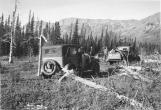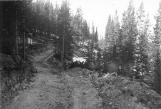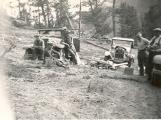8
A New Trail is Blazed in the Rockies!!By Freeda Fleming
Courtesy of the Ad-Viser Shop-O-Scope
(continued)
In 1940 Mr. Ross then master minded a plan to go through to Nordegg on the newly completed dirt and gravel road, and on to Windy Point another 25 miles, then blaze a wilderness trail on through another 40 miles to link up with the recently completed Banff-Jasper Highway at Saskatchewan River Crossing. Taking 2 vehicles, a Ford truck and vintage Chevrolet Coupe, he (Ernie Ross), Teddy Brett, Bill Schierholtz, Magnus Oppel and Bill Ellenburgh accomplished this monumental feat in 10 days and returned via Banff and Calgary. These men are the ones we have always spoken of as the original Trail Blazers, and the record of their venture reposes as history in the files of all the major newspapers of Western Canada, and even in some American ones and one London one.
11
Trail Blazers on the Kootenay Plains, circa 194620th Century, Circa 1946
The Kootenay Plains, Alberta, Canada
 Credits:
Credits:Rocky Museum
12
Bridge over the Siffleur River, with Excoelis Mountain behind1950 - 1960
The Kootenay Plains, Alberta, Canada
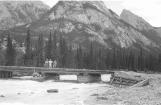 Credits:
Credits:Rocky Museum
13
A New Trail is Blazed in the Rockies!!By Freeda Fleming
Courtesy of the Ad-Viser Shop-O-Scope
(continued)
The next year (1941) they (The Trail Blazers) enlarged their party, adding Stan Hooker, Mr. F. D. Shaw, Federal member for Red Deer Constituency, Charlie Bruce and Father MacKenzie. Their vehicles were a 10 year old International truck, a model A Ford car, and Bill Ellenburgh's faithful old silver Chev that had gone the whole way the year before. They had power and clearance but there were no such things as 4-wheel drives and winches in those days. They had block and tackle, axes and shovels, and lots of man power. (Also the power of prayer. Why else had they taken Father MacKenzie?) Ten days later they were met at Saskatchewan River Crossing by George Brewster from Banff who had brought out emergency supplies of tires, gas, food and spare parts. These were needed as they were wet, cold, hungry, weary but triumphant. One car was limping along with a radius rod improvised from a tough sapling and some bits of wire, and some hand hewed slats taking the place of broken springs.
15
Trail Blazers camp at Whitegoat CreekCirca 1945
The West Country, Alberta, Canada
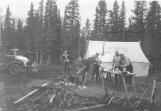 Credits:
Credits:Rocky Museum
16
A New Trail is Blazed in the Rockies!!By Freeda Fleming
Courtesy of the Ad-Viser Shop-O-Scope
(continued)
In 1945 they went again: Ross, Brett, Schierholtz, Ellenburgh, Hooker and a Mr. Brown and Mr. Pollock from Red Deer. Each trip saw a few more trees and stumps removed, more windfalls cleared out or detoured, and new courduroy laid across creeks and swamps. One member tells of crossing deep "washes" where the Forestry horse trails crossed on narrow single footpath width bridges. This time they had brought two stout planks. While the driver took the car across with the wheels on one side safely on the Forestry bridge, several men stood shoulder to shoulder down below holding the two planks steady to support the wheels on the other side. An undertaking not to be taken hurriedly. Fortunately no one lost his grip. This was a system Mr. Ross and Mary had invented on their 1931 trip.
For several years at this period the Canadian Government had established work camps for unemployed men, prisoners of war, and internees between Rocky and Nordegg, and the road here had become quite passable for much of the year, though still pretty primitive by today's standards. Motorists in recent years have complained of the dust (but) in those years you were glad it was dusty. That meant you didn't have to buck mud or snow.
17
Calculating the best place to ford the Whitegoat River, known now as the Cline River1940 - 1950
The West Country, Alberta, Canada
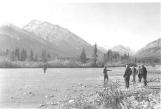 Credits:
Credits:Rocky Museum
18
Ernie Ross' Model A Ford fording a river, possibly the Whitegoat River1940 - 1950
The West Country, Alberta, Canada
 Credits:
Credits:Rocky Museum
19
Slowly, but surely, we'll get there1940 - 1950
The West Country, Alberta, Canada
 Credits:
Credits:Rocky Museum
20
A New Trail is Blazed in the Rockies!!By Freeda Fleming
Courtesy of the Ad-Viser Shop-O-Scope
(continued)
With a "good" road from Rocky to Windy Point, the 1946 crew made it in record time, 7 days to Banff and back. With great foresight they included as a working guest Jim McQueen, District Engineer for Department of Highways for this area. Some dynamite and powder men also fortunately were on hand. Gordon Sorensen, (of Sorensen Bus Lines) accompanied them, as well as Bill Fisher and Jim Horne, in addition to the ever faithful Ross, Schierholtz, Ellenburgh, Hooker and Father MacKenzie. Later Mr. McQueen made an official report to the Provincial Government supporting the Trail Blazer's previous claims that there were only two areas that entailed any costly construction, Whirlpool Point and Ski Hill, the rest would be quite simple. This proved true, for when Hon. Gordon Taylor officially opened the David Thompson Highway in 1968 he said the entire road had been built for the sum of three billion dollars. Since then paving had been added. It may now be truly termed a Highway of Happiness instead of Adventure Trail.
